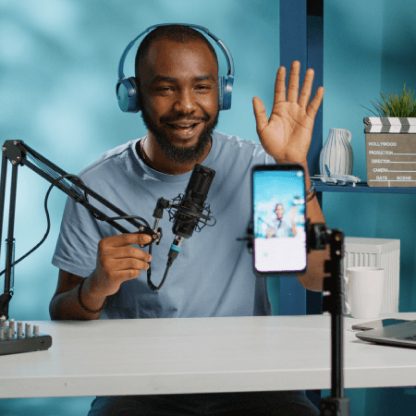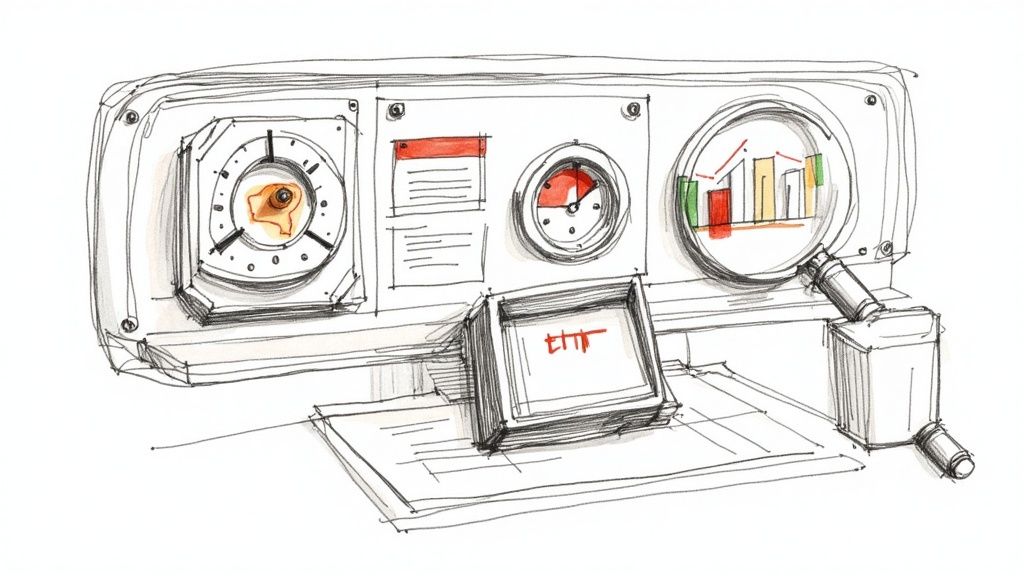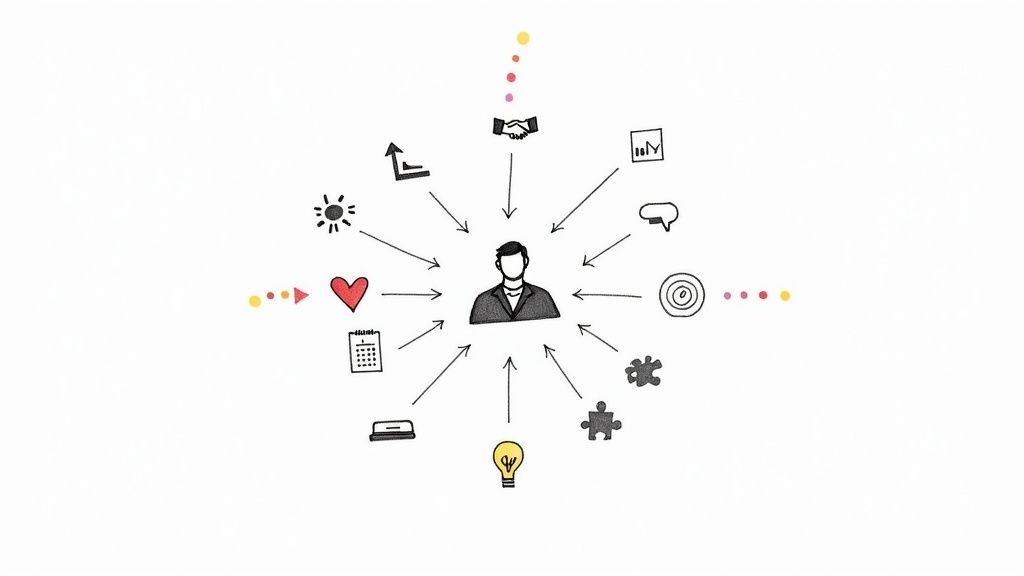Navigating the world of remote hiring requires more than just a stable internet connection; it demands a refined approach to inquiry. The right video interview questions are crucial for accurately assessing a candidate's skills, temperament, and potential fit from behind a screen. Without the subtle cues of an in-person meeting, your questions must work harder to reveal the depth of a candidate's experience and personality. This guide is designed to provide you with a strategic arsenal of questions, moving beyond the generic to uncover genuine insights.
This comprehensive listicle breaks down essential questions into key categories: behavioral, situational, technical, and culture-fit. Each item is presented with actionable tips on what to listen for in a response and how to adapt the question for different roles. We will explore how to structure your video interviews to get the most valuable information, ensuring you can confidently identify top-tier talent. Whether you're hiring for a technical role or a leadership position, these carefully curated questions will help you build a more effective, efficient, and insightful remote hiring process. By the end of this article, you'll have a practical framework for conducting video interviews that consistently lead to better hiring decisions.
1. Tell me about yourself
Often serving as the opening act in both live and asynchronous interviews, "Tell me about yourself" is one of the most fundamental video interview questions an employer can ask. Far from a simple icebreaker, this question is a strategic tool to assess a candidate's communication skills, self-awareness, and ability to connect their professional narrative directly to the role's requirements. It gives the candidate the floor, allowing you to observe how they structure a response and present themselves under pressure from the very beginning.

This question sets the tone for the entire interview. It's a prime opportunity to see if the candidate has done their research and can articulate their value proposition concisely. Top companies use this opener to gauge different attributes: Amazon, for example, listens for hints of their Leadership Principles, while Microsoft looks for a clear connection between the candidate’s past experiences and the specific team’s mission.
How to Evaluate the Response
A strong answer goes beyond a chronological recitation of a resume. Look for candidates who employ a structured approach, like the popular Present-Past-Future model.
- Present: They start with their current role, highlighting key responsibilities and a recent accomplishment relevant to your opening.
- Past: They briefly connect their current role to previous experiences that provided foundational skills for this next step.
- Future: They pivot to why they are interested in this specific opportunity and how their skills will contribute to your company's goals.
This structure demonstrates excellent communication and an understanding of what's important to you as the hiring manager. For a deeper dive into preparing for these types of questions, explore these pro tips for mastering your on-demand video interview.
What a Good Answer Looks Like
The best responses are typically 60 to 90 seconds long. This shows the candidate can be compelling and respectful of your time. Assess their non-verbal cues as well; confident body language, direct eye contact with the camera, and genuine enthusiasm are all positive indicators in a video format. A candidate who ends their response by expressing excitement for the conversation ahead shows engagement and strong interpersonal skills.
2. Why are you interested in this position?
A cornerstone of any interview, this question cuts directly to a candidate's motivation and the depth of their research. As one of the most revealing video interview questions, it allows you to separate the candidates who are truly passionate about the specific role and your company from those who are simply mass-applying. It’s your window into their career aspirations and how they envision themselves contributing to your team's success.
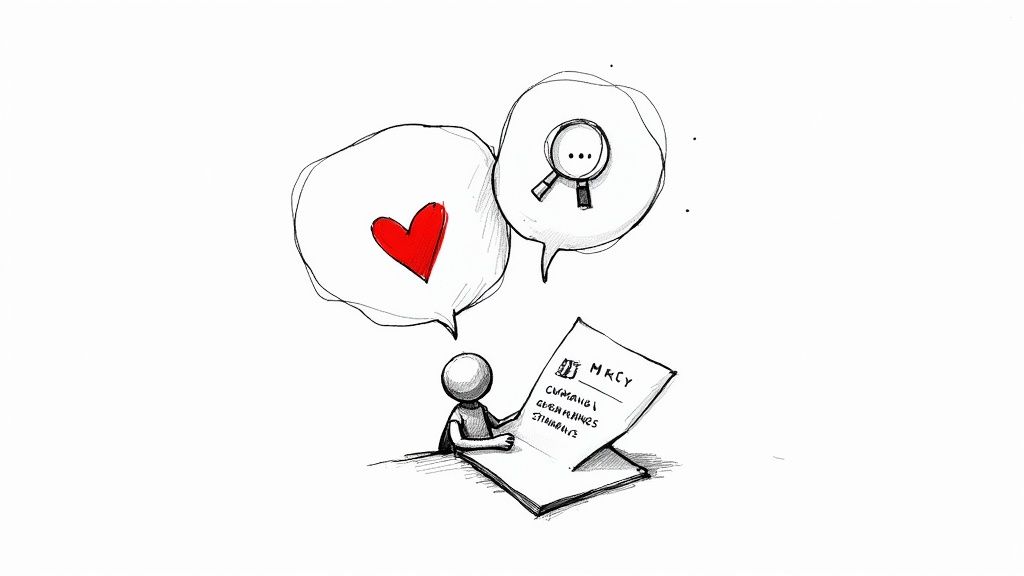
This question is a powerful tool to gauge alignment. For mission-driven companies like Tesla, a strong answer often connects personal values to the company's goal of accelerating sustainable energy. Similarly, non-profit organizations look for responses centered on social impact, while tech startups value answers highlighting a desire to innovate and be part of a high-growth environment. A well-prepared answer demonstrates genuine enthusiasm, not just a desire for any job.
How to Evaluate the Response
A compelling answer will seamlessly weave together three key elements: the role, the company, and the candidate's personal career trajectory. Generic praise for the company is a red flag; specificity is the hallmark of a great response.
- Role Alignment: Look for candidates who can articulate exactly which parts of the job description excite them and how their skills directly address those responsibilities.
- Company Connection: A strong candidate will reference your company's mission, recent projects, or unique culture, explaining why those aspects resonate with them.
- Future Focus: The best answers show how this position is a logical and ambitious next step in their career path, demonstrating long-term thinking.
What a Good Answer Looks Like
A standout response is authentic and specific. It moves beyond a simple "it seems like a great opportunity" and delves into the why. For instance, a candidate might say, "I've been following your recent launch of Project X, and I was particularly impressed by the innovative approach to data analytics. My experience in [specific skill] aligns perfectly with the challenges you described, and I'm excited by the chance to contribute to a team that's clearly a leader in the industry."
This type of detailed, enthusiastic answer shows they have not only done their homework but can also clearly visualize their impact within your organization. Pay attention to their delivery on video; genuine excitement in their tone and facial expressions can be a strong indicator of a great culture fit and a motivated future employee.
3. What are your greatest strengths?
A classic yet potent inquiry, "What are your greatest strengths?" is one of the most revealing video interview questions you can pose. It directly invites candidates to connect their core competencies with the job description. This question serves as a powerful diagnostic tool, assessing a candidate's self-awareness, confidence, and ability to articulate their value proposition in a relevant, tangible way. It's your chance to see if they understand what it truly takes to succeed in the role.
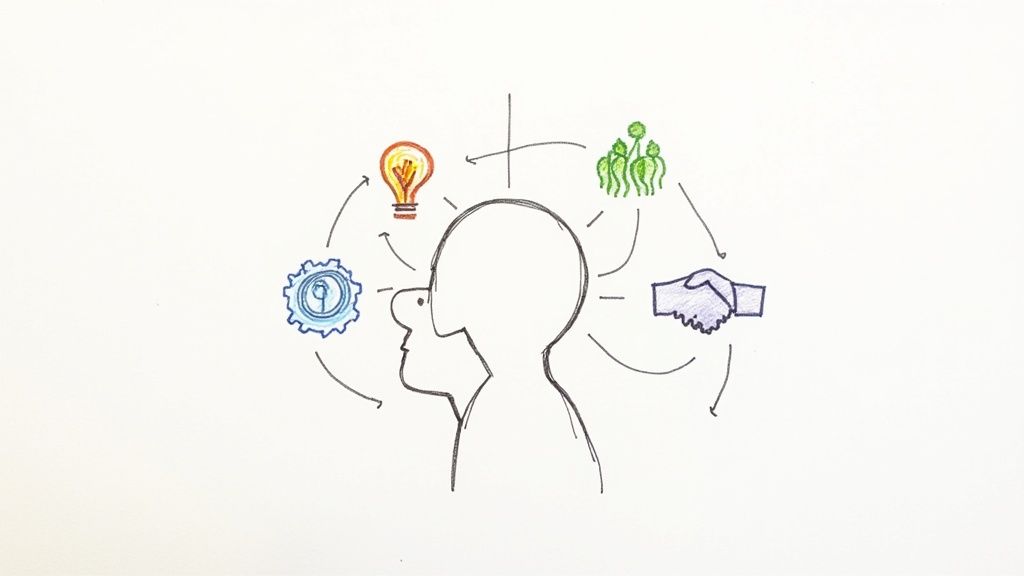
This question's effectiveness is rooted in its ability to filter candidates who have prepared thoughtfully versus those who have not. A generic answer indicates a lack of research, while a specific, evidence-backed response signals a high-potential hire. For example, a candidate for a sales role should highlight relationship-building and persuasion, while an engineer should focus on complex problem-solving and specific programming languages. This alignment is a critical indicator of a candidate's suitability.
How to Evaluate the Response
A compelling answer moves beyond simply listing adjectives. Look for candidates who provide concrete evidence for each strength, ideally using a framework like the STAR method (Situation, Task, Action, Result) to structure their examples.
- Relevance: The strengths they choose should align directly with the key requirements listed in the job description.
- Evidence: They must back up each strength with a brief, specific example or a measurable achievement.
- Authenticity: The response should feel genuine, avoiding clichés like "I'm a perfectionist" or "I work too hard," which often come across as disingenuous.
This structured, evidence-based approach demonstrates not only the claimed strength but also strong communication and analytical skills. For more insights on assessing candidate responses, consider exploring resources on strengths-based hiring strategies.
What a Good Answer Looks Like
The strongest responses are concise, focusing on two or three key strengths. Evaluate their delivery; confidence, clear articulation, and direct eye contact with the camera are crucial in a video interview. An excellent candidate will not only state their strength but also explicitly connect it to how they will add value to your team or organization, showing they've thought beyond themselves and about your company's needs.
4. What is your greatest weakness?
This classic and often dreaded question remains a staple in modern hiring, making it one of the most revealing video interview questions you can ask. Its purpose is to evaluate a candidate's self-awareness, honesty, and commitment to professional growth. Posed in a video interview, it also allows you to observe how a candidate handles a moment of vulnerability and frames a potential negative as a story of development and improvement.

This question helps identify potential red flags while simultaneously assessing character. Top-tier companies use this question to filter for candidates who are coachable and possess a growth mindset. How someone answers reveals their ability to be introspective and proactive, qualities that are invaluable in any role, from entry-level to senior leadership.
How to Evaluate the Response
A weak answer is either a clichéd non-weakness like "I'm a perfectionist" or a critical flaw that disqualifies them for the role. A strong response demonstrates genuine self-reflection and a proactive approach to improvement.
- Acknowledge a Real Weakness: The candidate should name a genuine, but not mission-critical, area for improvement. Examples include initial discomfort with public speaking, a tendency to overcommit, or a past struggle with delegating tasks effectively.
- Show Action and Progress: The core of the answer should detail the specific steps they have taken to address this weakness. This could be taking a course, seeking mentorship, or adopting new project management tools.
- Frame it as Growth: The candidate should conclude by explaining what they've learned and how the process of improving has made them a better professional.
This structured response turns a potential negative into a compelling story of professional development, showcasing resilience and a proactive attitude.
What a Good Answer Looks Like
The most effective answers are concise and pivot quickly from the weakness to the solution. Look for a candidate who can articulate their point in under 90 seconds. Their tone should be confident and matter-of-fact, not apologetic. A great response shows that the candidate is not defined by their weaknesses but by their dedication to overcoming them, turning a challenging question into a powerful demonstration of their character.
5. Where do you see yourself in 5 years?
This forward-looking question is a classic in the recruiter’s playbook and remains one of the most insightful video interview questions you can ask. It’s designed to gauge a candidate's career ambitions, planning skills, and whether their long-term goals align with the potential growth trajectory within your company. This question moves beyond immediate qualifications to explore a candidate's motivation, foresight, and potential for long-term retention.
The response reveals whether the candidate sees your role as a mere stepping stone or as a foundational part of their professional development. For organizations focused on building talent from within, such as large consulting firms or tech giants with clear career ladders, a candidate’s answer can be a critical indicator of culture fit and future engagement. It helps you understand if you can realistically meet their expectations.
How to Evaluate the Response
A strong answer will strike a balance between ambition and realism, demonstrating that the candidate has thought about their future but remains flexible. Look for responses that connect personal growth aspirations directly to the opportunities your role and company offer.
- Company Alignment: Does their plan involve growing with your organization? They should articulate how they see themselves contributing more significantly over time.
- Skill Development: The focus should be on acquiring new skills, taking on more complex responsibilities, or deepening their expertise rather than just chasing a specific job title.
- Realistic Ambition: The answer should be ambitious yet grounded. An entry-level candidate expecting a C-suite title in five years may have unrealistic expectations.
This approach shows they have researched typical career paths in your industry and are invested in a mutually beneficial long-term relationship. For more ideas on assessing candidate motivation, check out these top behavioral interview questions and answers.
What a Good Answer Looks Like
The most effective answers are thoughtful and specific without being overly rigid. A candidate might say, “In five years, I hope to have become a subject matter expert in [Relevant Area], taking the lead on challenging projects and mentoring junior team members. I was excited to see that your company supports [Specific Program or Growth Opportunity], and I believe this role is the perfect foundation to achieve that goal here.” This demonstrates enthusiasm, strategic thinking, and a clear interest in growing with you.
6. Describe a challenging situation you faced and how you handled it
This is a cornerstone of behavioral interviewing and one of the most revealing video interview questions you can ask. It moves beyond hypothetical scenarios to explore real-world evidence of a candidate's problem-solving skills, resilience, and decision-making capabilities under pressure. The goal is to see how they navigate professional adversity and learn from the experience.
This question provides a window into a candidate's practical competence and emotional intelligence. For a project manager, the challenge might involve navigating unexpected scope creep and managing stakeholder expectations. A software developer could describe debugging a critical, elusive bug under a tight deadline. The specifics of the story are less important than the process and outcome a candidate shares.
How to Evaluate the Response
The gold standard for answering this question is the STAR method. A well-structured answer will follow this framework, giving you a clear, concise, and compelling narrative of their capabilities.
- Situation: They begin by setting the scene and providing necessary context for the challenge.
- Task: They clearly define their specific role and responsibilities within that situation.
- Action: This is the core of the answer. They detail the specific steps they took to address the challenge, highlighting their thought process and decisions.
- Result: They conclude by sharing the outcome of their actions, quantifying the success with metrics or specific data whenever possible.
Look for candidates who take ownership of their actions rather than placing blame. A strong response demonstrates not just what they did, but also what they learned from the experience. For more insights on handling tough scenarios, you can find strategies for tackling workplace issues with grace.
What a Good Answer Looks Like
An ideal response is focused, relevant to the role, and demonstrates critical thinking. Pay attention to how the candidate frames the "challenge"; do they see it as a roadblock or an opportunity for growth? The best answers showcase proactivity, collaboration, and a positive, results-oriented mindset. Their ability to articulate the resolution clearly in the video format also speaks to their communication skills, a key attribute for nearly any position.
7. Why are you leaving your current job?
This question is a staple in the recruiter's toolkit and one of the most revealing video interview questions you can ask. Its purpose is to uncover a candidate's motivations, professionalism, and career aspirations. How a candidate frames their departure speaks volumes about their attitude, resilience, and what they are genuinely seeking in their next role. It's a critical checkpoint for identifying potential red flags like unresolved conflicts or a history of poor performance.
This question provides a window into a candidate's career drivers. It helps you assess whether their reasons for leaving align with the opportunities your company offers, which is a strong predictor of long-term satisfaction and retention. Companies use this to ensure the candidate is running towards a new challenge rather than just running away from a bad situation, which could repeat itself in a new environment.
How to Evaluate the Response
A well-crafted answer should be positive, forward-looking, and diplomatic. You're not looking for someone to speak negatively about a previous employer; that's often a major red flag. Instead, look for answers that focus on growth, opportunity, and alignment with their future goals.
- Positive Framing: The candidate should emphasize what they hope to gain in a new role, not what they disliked about their old one. Look for mentions of seeking new challenges, skill development, or contributing to a mission they believe in.
- Professionalism: Listen for a respectful and professional tone when discussing their current or former company and colleagues. Blaming others or complaining suggests a lack of accountability.
- Alignment: The best candidates will directly connect their reasons for leaving to specific aspects of the job you're offering, showing they've done their research and see a genuine fit.
What a Good Answer Looks Like
A strong response is concise, honest, and strategically aligned with your company's value proposition. For example, a candidate might say, "I've gained valuable experience in project management at my current company, but I'm looking for an opportunity to take on a larger leadership role, which I see is a key part of this position." This answer is positive, demonstrates ambition, and directly links their career goals to your opening. It shows maturity and a clear, intentional career path.
8. Do you have any questions for us?
Often the final question in an interview, this closing prompt is one of the most revealing video interview questions you can ask. It shifts the dynamic, transforming the interview from a one-way evaluation into a two-way conversation. How a candidate responds reveals their level of preparation, genuine interest in the role, and what they prioritize in a new opportunity. It is a critical moment to assess their engagement and foresight.
This question is your opportunity to gauge how deeply a candidate has considered their future with your organization. A thoughtful, well-researched question demonstrates that the candidate is not just looking for any job, but for this job. Companies like Google and Netflix value this part of the interview to see if a candidate’s curiosity aligns with their culture of continuous learning and proactive engagement. It is a powerful indicator of their potential cultural fit and long-term commitment.
How to Evaluate the Response
The quality of the questions asked is far more important than the quantity. Look for candidates who move beyond generic inquiries and ask questions that reflect research into your company, the specific team, or recent industry developments.
- Strategic and Role-Specific Questions: Does the candidate ask about the key challenges for this role in the first six months, or how success will be measured? This shows they are already visualizing themselves in the position.
- Team and Culture-Focused Questions: Inquiries about team dynamics, collaboration styles, or how the company lives its stated values indicate a desire to integrate and contribute positively to the work environment.
- Forward-Looking Questions: Questions about professional development, growth opportunities, or the company's future direction show long-term interest and ambition.
Avoid candidates whose only questions are about salary, benefits, or time off, especially in an initial interview. While these are important, leading with them can suggest their primary motivation is transactional rather than a genuine interest in the role itself. For more insights on this, review these tips for successful job interviews.
What a Good Answer Looks Like
A strong candidate will have 2-3 prepared questions ready. Their delivery should be as important as the questions themselves. Look for genuine curiosity and active listening in their tone and body language, even through a screen. A great candidate will often tie their question back to something discussed earlier in the interview, demonstrating they were paying close attention. For example, "You mentioned the team is working on a major product launch next quarter. What does the onboarding process look like to get a new team member up to speed for that deadline?" This level of specific, engaged questioning is the hallmark of a top-tier applicant.
Top 8 Video Interview Questions Comparison
| Interview Question | Implementation Complexity 🔄 | Resource Requirements ⚡ | Expected Outcomes 📊 | Ideal Use Cases 💡 | Key Advantages ⭐ |
|---|---|---|---|---|---|
| Tell me about yourself | Low 🔄 | Low ⚡ | Insight into personality and communication 📊 | Opening icebreaker, assessing storytelling | Controls narrative, eases anxiety ⭐ |
| Why are you interested in this position? | Medium 🔄 | Medium ⚡ | Gauge motivation and alignment 📊 | Motivated candidates, cultural fit screening | Reveals genuine enthusiasm, preparation ⭐ |
| What are your greatest strengths? | Medium 🔄 | Low ⚡ | Highlight relevant skills and confidence 📊 | Skill validation, self-promotion | Differentiates candidate, builds confidence ⭐ |
| What is your greatest weakness? | Medium 🔄 | Low ⚡ | Assess honesty and growth mindset 📊 | Self-awareness test, maturity assessment | Shows self-improvement and maturity ⭐ |
| Where do you see yourself in 5 years? | Medium 🔄 | Low ⚡ | Understand career ambition and longevity 📊 | Career planning, leadership potential | Reveals ambition and alignment ⭐ |
| Describe a challenging situation you faced and how you handled it | High 🔄 | Medium ⚡ | Demonstrate problem-solving and resilience 📊 | Behavioral assessment, stress response | Concrete examples of performance ⭐ |
| Why are you leaving your current job? | Medium 🔄 | Low ⚡ | Identify motivations and potential red flags 📊 | Career transitions, screening for issues | Opportunity to explain professionally ⭐ |
| Do you have any questions for us? | Low 🔄 | Low ⚡ | Reveal engagement and research level 📊 | Interview closing, candidate evaluation | Demonstrates interest, strategic thinking ⭐ |
Final Thoughts
Navigating the landscape of modern recruitment requires more than just knowing what to ask; it demands a strategic approach to how and why you ask it, especially in a virtual setting. Throughout this guide, we've deconstructed some of the most common yet powerful video interview questions, transforming them from simple queries into robust tools for talent assessment. The goal is to move beyond rehearsed answers and uncover genuine insights into a candidate's capabilities, personality, and potential.
The true art of interviewing lies in the synthesis of different question types. By thoughtfully blending behavioral, situational, technical, and culture-fit questions, you create a comprehensive picture of each applicant. This isn't about catching candidates off guard; it's about providing them with a platform to demonstrate their value in a multi-faceted way.
Key Takeaways for Effective Video Interviews
To elevate your hiring process, keep these core principles at the forefront:
- Clarity is Paramount: Ensure every question is clear, concise, and directly linked to a specific competency or requirement of the role. Ambiguity leads to vague answers and wastes valuable interview time.
- Contextualize Your Questions: Generic questions yield generic responses. Tailor your inquiries to reflect your company's unique challenges, culture, and the specific demands of the position you're hiring for. For example, instead of asking about a "challenge," ask about a challenge related to a specific project type they'll encounter in the role.
- Balance Assessment with Experience: Remember that the interview is a two-way street. The questions you ask and the way you ask them heavily influence the candidate's experience and their perception of your organization. A well-structured interview process that respects the candidate's time and intellect is a powerful branding tool.
- Leverage the Video Format: Use the unique aspects of video to your advantage. Asynchronous interviews allow candidates to respond thoughtfully on their own time, while live interviews provide a window into their real-time problem-solving and communication skills.
Your Actionable Next Steps
Mastering the art of the interview is an ongoing process. Start by reviewing your current list of video interview questions. Identify which ones are truly effective and which have become rote or outdated. Begin integrating the structured, competency-based approaches we've discussed, starting with one or two key roles.
Ultimately, the right questions do more than just fill a position; they build the foundation of a resilient, high-performing team. By investing time in refining your interview strategy, you are not just hiring an employee, you are making a strategic investment in your organization's future. The insights you gain from a well-executed video interview process are invaluable, ensuring that every new hire doesn't just fit the job description but actively contributes to your company's long-term success.
Ready to streamline your hiring and standardize your video interview questions at scale? Async Interview provides a powerful asynchronous video interview platform that helps you screen more candidates effectively and identify top talent faster. Discover how you can build a better interview process by visiting Async Interview today.
